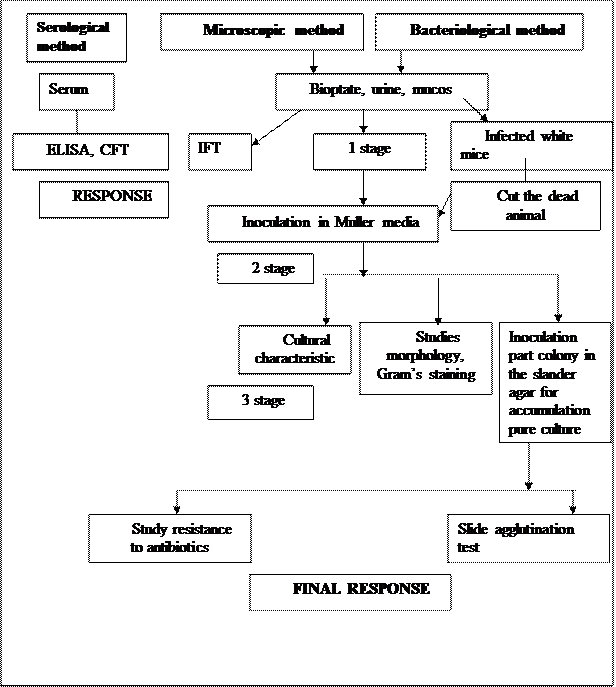
CATEGORIES:
BiologyChemistryConstructionCultureEcologyEconomyElectronicsFinanceGeographyHistoryInformaticsLawMathematicsMechanicsMedicineOtherPedagogyPhilosophyPhysicsPolicyPsychologySociologySportTourism
Microbiological research of the Legionella infection


Microbiological research of the Listeriosis


Microbiological research of the infection caused by non-pathogenic microorganisms
Specimensselected should adequately represent the diseased area and also may include additional sites (e.g., liver and blood specimens) in order to isolate and identify potential agents of the particular disease process.



ALGORITHM OF ACTIONS
DURING CONDUCTION OF CLINICAL MICROBIOLOGY
Specimens
The major focus of the clinical microbiologistis to isolate and identify microorganisms from clinical specimens rapidly. The purpose of the clinical microbiology laboratory is to provide the physician with information concerning the presence or absence of microorganisms that may be involved in the infectious disease process. These individuals and facilities also determine the susceptibility of microorganisms to antimicrobial agents. Clinical microbiology makes use of information obtained from research on such diverse topics as microbial biochemistry and physiology, immunology, molecular biology, genomics, and the hostparasite relationships involved in the infectious disease process. In clinical microbiology a clinical specimen (hereafter, specimen) represents a portion or quantity of human material that is tested, examined, or studied to determine the presence or absence of particular microorganisms. Safety for the patients, hospital, and laboratory staff is very important. The guidelines presented in Box 1(Universal Precautions for Health-Care Professionals) were established by the Centers for Disease Control and Prevention (CDC) to address areas of specimen handling. Other important concerns regarding specimens need emphasis:
1. The specimen selected should adequately represent the diseased area and also may include additional sites (e.g., liver and blood specimens) in order to isolate and identify potential agents of the particular disease process.
2. A quantity of specimen adequate in amount to allow a variety of diagnostic testing should be obtained.
3. Attention must be given to specimen collection in order to avoid contamination from the many varieties of microorganisms indigenous to the skin and mucous membranes.
4. The specimen should be forwarded promptly to the clinical laboratory.
5. If possible, the specimen should be obtained before antimicrobial agents have been administered to the patient.
Collection

 Overall, the results obtained in the clinical laboratory are only as good as the quality of the specimen collected for analysis. Specimens may be collected by several methods using aseptic technique. Aseptic technique refers to specific procedures used to prevent unwanted microorganisms from contaminating the clinical specimen. Each method is designed to ensure that only the proper material will be sent to the clinical laboratory. The most common method used to collect specimens from the anterior nares or throat is the sterile swab. A sterile swab is a rayon-, calcium alginate, or dacron-tipped polystyrene applicator. Manufacturers of swabs have their own unique container design and instructions for proper use. For example, many commercially manufactured swabs contain a transport medium designed to preserve a variety of microorganisms and to prevent multiplication of rapidly growing members of the population (figure 1a). However, with the exception of the nares or throat, the use of swabs for the collection of specimens is of little value and should be discouraged for two major reasons: swabs are associated with a greater risk of contamination with surface and subsurface microorganisms, and they have a limited volume capacity (0.1 ml).
Overall, the results obtained in the clinical laboratory are only as good as the quality of the specimen collected for analysis. Specimens may be collected by several methods using aseptic technique. Aseptic technique refers to specific procedures used to prevent unwanted microorganisms from contaminating the clinical specimen. Each method is designed to ensure that only the proper material will be sent to the clinical laboratory. The most common method used to collect specimens from the anterior nares or throat is the sterile swab. A sterile swab is a rayon-, calcium alginate, or dacron-tipped polystyrene applicator. Manufacturers of swabs have their own unique container design and instructions for proper use. For example, many commercially manufactured swabs contain a transport medium designed to preserve a variety of microorganisms and to prevent multiplication of rapidly growing members of the population (figure 1a). However, with the exception of the nares or throat, the use of swabs for the collection of specimens is of little value and should be discouraged for two major reasons: swabs are associated with a greater risk of contamination with surface and subsurface microorganisms, and they have a limited volume capacity (0.1 ml).
Needle aspiration is used to collect specimens aseptically (e.g., anaerobic bacteria) from cerebrospinal fluid, pus, and blood. For both samples stringent antiseptic techniques are used to avoid skin contamination. To prevent blood from clotting and entrapping microorganisms, various anticoagulants (e.g., heparin, sodium citrate) are included within the specimen bottle or tube (figure 1b).
Intubation[Latin in, into, and tuba, tube] is the inserting of a tube into a body canal or hollow organ. For example, intubation can be used to collect specimens from the stomach. In this procedure
a long sterile tube is attached to a syringe, and the tube is either swallowed by the patient or passed through a nostril into the patientís stomach. Specimens are then withdrawn periodically into the sterile syringe. The most common intubation tube is the Levin tube.
A catheter is a tubular instrument used for withdrawing or introducing fluids from or into a body cavity. For example, urine specimens may be collected with catheters to detect urinary tract infections caused by bacteria and from newborns and neonates who cannot give a voluntary urinary specimen. Three types are commonly used for urine. The hard catheter is used when the urethra is
very narrow or has strictures. The French catheter is a soft tube used to obtain a single specimen sample. If multiple samples are required over a prolonged period, a Foley catheter is used. The most common method used for the collection of urine is the clean-catch method. After the patient has cleansed the urethral meatus (opening), a small container is used to collect the urine. The optimal time to use the clean-catch method is early morning because the urine contains more microorganisms as a result of being in the bladder overnight. In the clean-catch midstream method, the first urine voided is not collected because it will be contaminated with those transient microorganisms normally occurring in the lower portion of the urethra. Only the midstream portion is collected since it most likely will contain those microorganisms found in the urinary bladder. If warranted for some patients, needle aspirations also are done directly into the urinary bladder. Sputum is the most common specimen collected in suspected cases of lower respiratory tract infections. Specifically, sputum is the mucous secretion expectorated from the lungs, bronchi, and trachea through the mouth, in contrast to saliva, which is the secretion of the salivary glands. Sputum is collected in specially designed sputum cups.
Date: 2016-01-14; view: 1206
| <== previous page | | | next page ==> |
| Clinical microbiology | | | LABORATORY DIAGNOSTIC OF THE OPORTUNISTIC INFECTIONS |